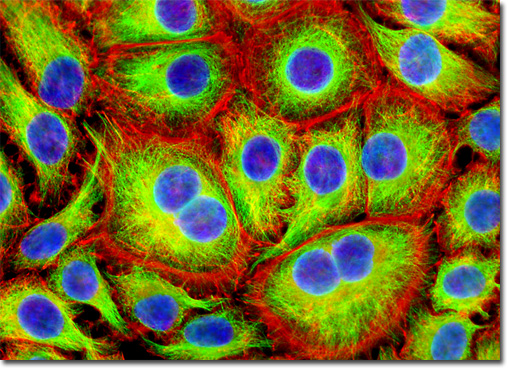Fluorescence Digital Image Gallery
Human Cervical Adenocarcinoma Cells (HeLa)
|
Cells of epithelial tissue turn over at a rapid rate, which makes maintaining the integrity of the sheets a more significant process than in many other areas of the body. When epithelial cells manage to evade the typical division and growth controls placed upon them, a tumor, or neoplasm, may develop. In some cases, this growth does not spread to other areas, in which case it is considered benign. Once a tumor metastasizes, however, it is described as malignant. Carcinoma is a malignant tumor that is epithelial in origin, arising on surface tissues of the skin, various organs, or blood vessels. Adenocarcinomas, such as the one that served as the source of HeLa cells, are carcinomas that begin in glandular epithelial tissue. These tumors generally arrange themselves in a glandular form, similar to the tissues that they invade. The human cervical adenocarcinoma cells (HeLa) appearing in the digital image above were immunofluorescently labeled with anti-tubulin mouse monoclonal primary antibodies followed by goat anti-mouse Fab fragments conjugated to the cyanine dye, Cy2. The culture was counterstained for DNA with Hoechst 33258, and for the cytoskeletal F-actin network with Alexa Fluor 568 conjugated to phalloidin. Images were recorded in grayscale with a QImaging Retiga Fast-EXi camera system coupled to an Olympus BX-51 microscope equipped with bandpass emission fluorescence filter optical blocks provided by Omega Optical. During the processing stage, individual image channels were pseudocolored with RGB values corresponding to each of the fluorophore emission spectral profiles. |
© 1995-2025 by Michael W. Davidson and The Florida State University. All Rights Reserved. No images, graphics, software, scripts, or applets may be reproduced or used in any manner without permission from the copyright holders. Use of this website means you agree to all of the Legal Terms and Conditions set forth by the owners.
This website is maintained by our
|
